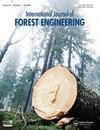Productivity and costs of sieving logging residue chips
IF 2.1
3区 农林科学
Q2 FORESTRY
引用次数: 1
Abstract
ABSTRACT Sieving of chipped forest fuels has recently been suggested as a way to reduce dry matter losses during storage. Sieving provides a more homogeneous acceptable material with better storage properties, which reduces the risk of energy and dry matter losses and spontaneous ignition. Screened chips can be priced higher due to better quality, and both acceptable and reject fractions are more homogeneous, which improves combustion control. Sieving is costly and the reject fraction is not suitable for storage. Five sieving operations were studied, three involving vibrating screens and two involving starscreens. On average, starscreens were more productive than vibrating screens. In all operations, the sieving machine limited productivity, and the loader feeding the machine was not fully utilized. Sieving costs were under two euro per MWh of chips, which may be recovered through higher values and lower storage losses in the acceptable fraction. If sieving operations were used to increase storage of chips, it could increase the annual utilization of chippers and chip trucks in the supply chain, thereby reducing supply costs. Profitable sieving operations require demand for the fine fraction at a price close to that of residue chips.筛分伐木残渣碎片的生产率和成本
摘要:最近有人提出,对碎森林燃料进行筛分是减少储存过程中干物质损失的一种方法。筛分提供了一种更均匀、可接受的材料,具有更好的储存性能,降低了能量和干物质损失以及自燃的风险。由于质量更好,筛屑的价格可以更高,可接受和不可接受的馏分都更均匀,这提高了燃烧控制。筛分成本高,废品部分不适合储存。研究了五种筛分操作,其中三种涉及振动筛,两种涉及星筛。平均而言,星筛比振动筛更有效率。在所有操作中,筛分机限制了生产率,给机器进料的装载机没有得到充分利用。筛分成本低于每MWh芯片两欧元,可以通过更高的价值和更低的可接受部分的存储损耗来回收。如果使用筛分操作来增加芯片的储存,则可以增加供应链中切片机和芯片车的年利用率,从而降低供应成本。有利可图的筛分操作需要以接近残渣碎片的价格对细馏分进行需求。
本文章由计算机程序翻译,如有差异,请以英文原文为准。
求助全文
约1分钟内获得全文
求助全文

 求助内容:
求助内容: 应助结果提醒方式:
应助结果提醒方式:


